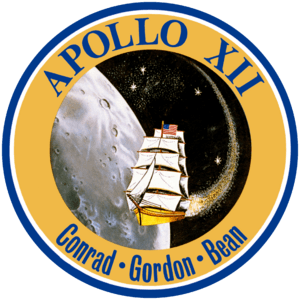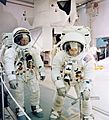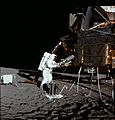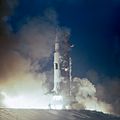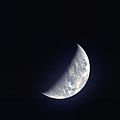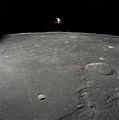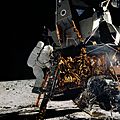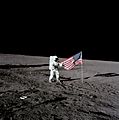Apollo 12 facts for kids
Apollo 12 was a very important space mission. It was the sixth time humans flew into space as part of the Apollo program. It was also the second time astronauts landed on the Moon! The mission launched on November 14, 1969. Two brave astronauts, Charles "Pete" Conrad and Alan Bean, became the third and fourth people ever to walk on the Moon. Their fellow astronaut, Richard Gordon, stayed in orbit around the Moon in the command ship.
Conrad and Bean spent over seven hours exploring the Moon's surface. They landed in an area called the Ocean of Storms. They even visited an old robot spacecraft called Surveyor III, which had landed there in 1967. They brought back parts of it for scientists to study. The astronauts also set up many science tools that kept collecting information after they left. To learn more about the Moon's inside, they crashed the part of their spaceship that took off from the Moon back onto its surface. This made shock waves that were measured by special equipment they left behind.
Contents
The Apollo 12 Mission
Apollo 12 was a big step for space travel. It showed that astronauts could land very close to a specific spot on the Moon. This was important for future missions. The main goals were to explore the Moon, collect samples, and set up science experiments.
Meet the Crew
The Apollo 12 crew had three amazing astronauts:
- Charles "Pete" Conrad was the mission commander. He was the first of the two to step onto the Moon.
- Alan Bean was the lunar module pilot. He was the second person to walk on the Moon during this mission.
- Richard Gordon was the command module pilot. He orbited the Moon alone while Conrad and Bean were on the surface.
Journey to the Moon
Apollo 12 launched from Kennedy Space Center in Florida. It used a giant Saturn V rocket. The launch happened during a thunderstorm. Lightning actually struck the rocket twice! This caused some problems with the spacecraft's power. But the quick thinking of the mission control team saved the day. They helped the astronauts fix the issues. After that, the journey to the Moon was smooth.
Landing on the Moon
The mission aimed for a very precise landing. They wanted to land near the Surveyor III probe. This probe had landed on the Moon two years earlier. The astronauts used a special part of their spacecraft called the Lunar Module, named Intrepid, to land. Conrad guided the Intrepid to a soft landing. They landed just 600 feet (about 180 meters) away from the Surveyor III probe. This was a huge success for NASA.
Exploring the Lunar Surface
Conrad and Bean spent about 31 hours on the Moon. They went on two spacewalks, also called Extravehicular Activities (EVAs). During these walks, they explored the area around their landing site. They collected rocks and soil samples. They also took many pictures of the Moon's surface.
Scientific Experiments
A big part of their mission was setting up the Apollo Lunar Surface Experiments Package (ALSEP). This was a set of science tools. It included:
- A seismometer to measure "moonquakes."
- A solar wind experiment to study particles from the Sun.
- A magnetometers to measure magnetic fields.
- Other tools to study the Moon's atmosphere and surface.
These experiments sent data back to Earth for many years.
Visiting Surveyor III
One of the most exciting parts was visiting the Surveyor III probe. It was a robot spacecraft that had landed on the Moon in 1967. Conrad and Bean walked to it. They took pictures of it and removed some parts. These parts were brought back to Earth. Scientists studied them to see how the Moon's environment affected the materials. This helped engineers design better spacecraft for future missions.
Leaving the Moon
After their exploration, Conrad and Bean got back into the Intrepid lunar module. The top part of the Intrepid then blasted off from the Moon. It rejoined the command module, Yankee Clipper, which was orbiting the Moon with Richard Gordon inside. The lower part of the Intrepid was left behind on the Moon.
Back to Earth
The three astronauts then began their journey back to Earth. The command module splashed down safely in the Pacific Ocean on November 24, 1969. The crew was picked up by a recovery ship. Apollo 12 was a very successful mission. It helped us learn a lot more about our closest neighbor in space.
Images for kids
-
Lunar Module Intrepid above the Moon. The small crater in the foreground is Ammonius; the large crater at right is Herschel. Photograph by Richard F. Gordon Jr. on board the Command Module Yankee Clipper.
-
Apollo 12 CM Yankee Clipper on display at the Virginia Air and Space Center in Hampton, Virginia
See also
 In Spanish: Apolo 12 para niños
In Spanish: Apolo 12 para niños


